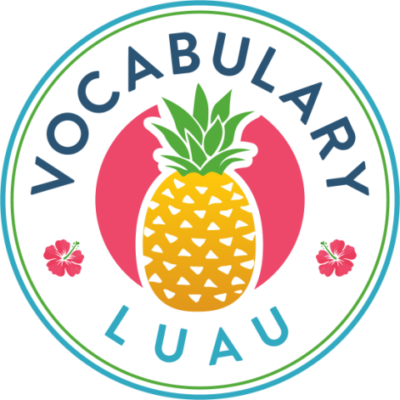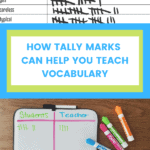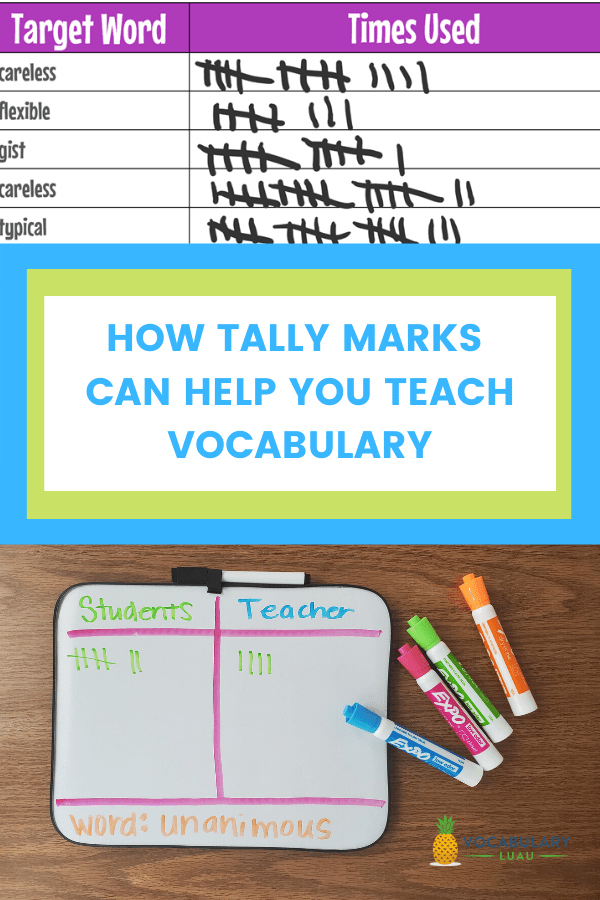We’re used to using tally marks for math, but tally marks can help you teach vocabulary, too.
It’s very simple: just use tally marks to track words you’re trying to practice.
Like anything else that sounds simple, there’s more to it if you dive in!
? How to Use Tally Marks to Practice New Vocabulary
I use two primary activities when I have students practice vocabulary with tally marks.
Idea #1: Have students mark whenever the teacher says the word in context, and mark twice when a student does. See how many marks everyone can get combined.
Idea #2: Mark one tally mark no matter who says it, but play it as a teacher versus the class game.
You can do this on a board, a screen, or paper.
I usually use a dry erase board I picked up at the dollar store.
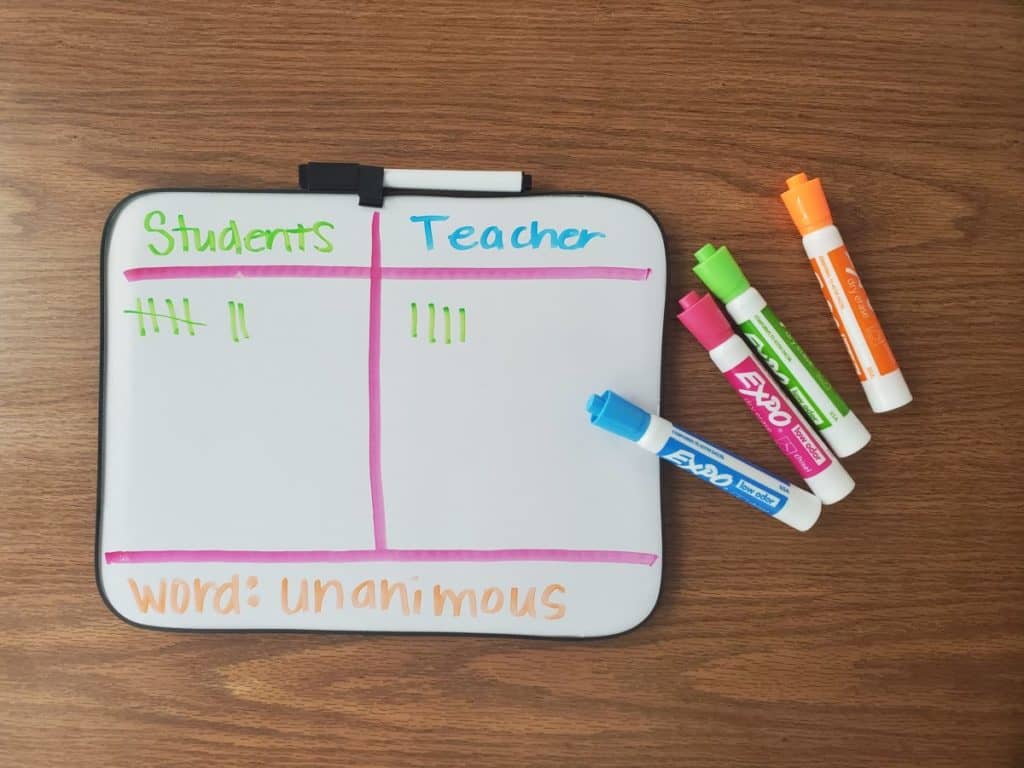
If you’ve read some of my other ideas, you probably already know I’m a huge fan of the dollar store!
? Explaining the Tally Marks Activity to Students
It’s very simple to explain this activity to students.
First Variation
For the first variation where everyone is playing as a class, simply say something like:
“We’ve been learning the new word tentative. We’re going to play a little game with it.
Every time I say the word tentative, I get a tally mark in this column (indicate “teacher” column).
Every time you say the word tentative, you get two tally marks in this column (indicate “student” column).
We’re going to see how many we can get all together!
Now, the word has to be used appropriately. It doesn’t count to use it in a way that doesn’t make sense or to just say it out loud.
It has to be a part of a sentence that makes sense.
Let’s see how well we do today!”
Optionally, you can have them set a goal for how many tallies they think they can get in a class period.
Second Variation
For the second variation (teacher v. students), explain it like this:
“We’ve been learning the new word drastic. We’re going to play a little game with it.
Every time I say the word drastic, I get a tally mark in this column (indicate “teacher” column).
Every time you say the word drastic, you get a tally mark in this column (indicate “student” column).
We’re going to see who can use it more – me or you!
Now, the word has to be used appropriately. It doesn’t count to use it in a way that doesn’t make sense or to just say it out loud.
It has to be a part of a sentence that makes sense.
We don’t need to go to any drastic measures, but let’s see what we can do!”
Should You Award Prizes for Vocabulary Tally Marks?
You can decide if there is some kind of bounty or prize to the winner.
It’s optional, but it does make it even more fun.
Examples I’ve used include:
- Minutes of extra silent reading
- Bonus point on a vocabulary test or quiz
- One-minute dance party
- Who picks the playlist
- Teacher eats lunch in cafeteria with kids
- Teacher talks like Yoda the rest of the day (very popular!)
The sky’s the limit. You know what your kids value.
? Why Are Tally Marks a Good Strategy for Vocabulary Practice?
There’s a part of our brains called the Reticular Activating System that impacts what we pay attention to.
One thing that triggers it to pay attention is when something is new or attached to a reward.
When we’re working with a new target word, having students use tallies alerts the RAS that this word is worth paying attention to.
Additionally, an important element of acquiring vocabulary is integrating it into use in speech and writing.
This activity encourages students to recognize when target words are being used and will (hopefully!) encourage them to use the word themselves.
? Variations on Using Tally Marks to Practice Vocabulary
While those are the two most common ways I use this strategy, there are some variations that keep it fresh.
- Play against another class
- Search texts or the internet for the word and add that to the tally
- Have students continue play at home with families (This one is hysterical because you’ll get emails from parents whose three-year-olds start walking around saying, “I’m famished.”)
- Pit two texts against each other to see which one has more applications of the word. It’s unlikely the text will have lots of examples of the word, but it will have times when you can use the word to discuss the text.
- Play until a certain number of tallies has been reached (rather than a certain amount of time).
- Pit two words against each other to see which word can get more tallies.
- Use the same strategy, but in writing instead of discussion.
? Using Tally Charts in Vocabulary Practice
In addition to the tally marks, I like to use tally charts as well.
To do this, save the data from a number of times you’ve used this strategy.
I just take a picture of the tally boards, but you can do it more formally if you like.
Once I have five or so words we’ve done, I have the students create tally charts to compare the words.
Sometimes I have them set the chart up themselves, and sometimes I give them a chart with the words already on it.
They then look at the data from previous classes and fill in the chart.
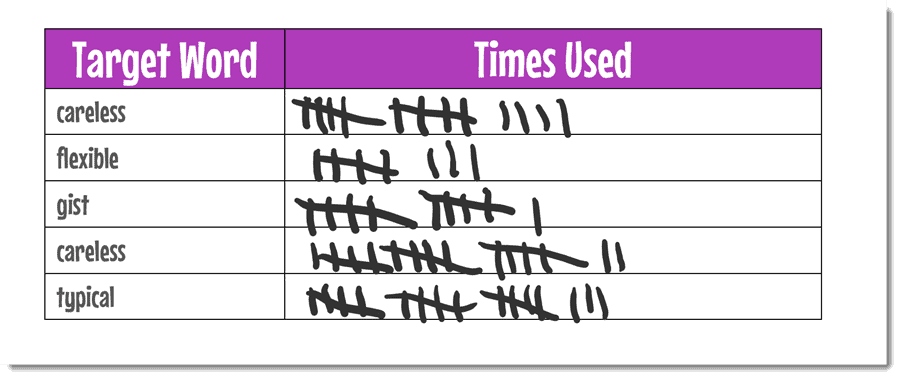
Once they’ve filled in the chart, we have a discussion about it.
I ask questions like:
- Was the word used most often then the one you use most often now?
- Did any words surprise you? Did you think they’d be more or less used than they actually were?
- Had you forgotten any of the words?
- Would people outside of our class have similar results in their everyday vocabulary?
- In what ways does the frequency of a word’s use reflect its importance? In what ways does it not?
? Wrapping Up:
Language Arts teachers often encourage other content areas to read and write across the curriculum. It’s equally important that we incorporate mathematics principles across the curriculum, too.
By using tally marks in class, we send the message that math tools and strategies apply in a wide range of ways.
This activity is super low prep (all you really need is a target word), which makes it ultra useful. It’s also flexible as far as grade levels. It can be played equally effectively with seven-year-olds and seventeen-year-olds. I love that!
Most importantly, anecdotally I’ve found that it really does lead students to use the words more often, which is the real goal.
I hope you like it as much as I do!?
